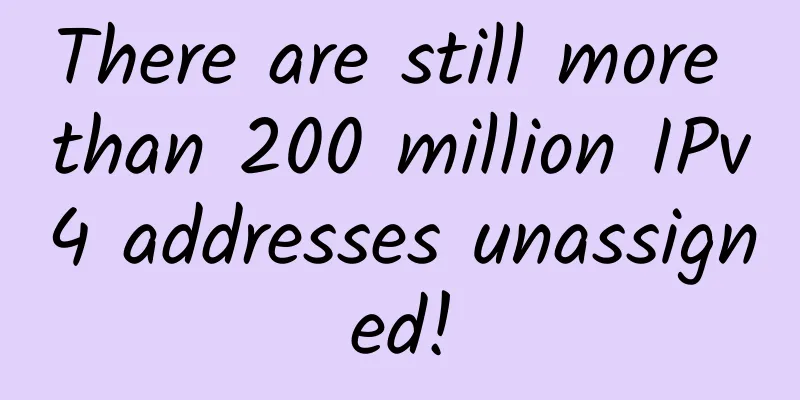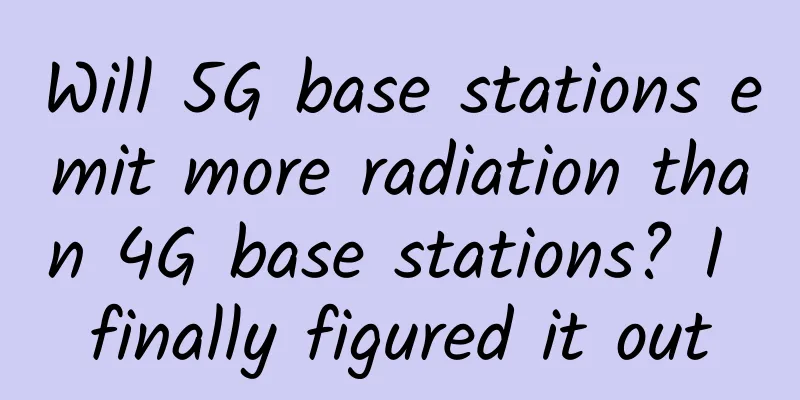There are still more than 200 million IPv4 addresses unassigned!

|
Hello everyone, I’m Xiaofu. In 2019, there were reports that IPv4 addresses had been used up, and it was thought that IPv6 would completely replace IPv4. As a result, over the past two years, IPv4 is still the mainstream, and IPv6 has also been launched in part, but it is more like a decoration and is not actually used. Let’s start from the beginning and find out! What is an IP address?192.168.1.123, 10.10.10.10, 121.14.77.221, etc. These are all IP addresses. If you look closely, you will find that the IP address is composed of 4 numbers and the "." in the middle. In fact, each number is composed of eight binary digits and converted into decimal representation, with a value range of 0 ~ 255. In other words, an IP address is composed of 32-bit binary numbers. For ease of writing, each group of eight bits is separated by ".", and each group of data is converted into decimal representation. What is an IP address used for?IP addresses are divided into public and private addresses. Public IP addresses can be used to access the Internet and Internet resources, such as WeChat chats, Tik Tok videos, etc. Private IP addresses are used in local area networks, and can be used to connect to a TV at home to cast screens, print to a printer, etc. The public network address is assigned by the Internet NIC. The private network address is a reserved IP address that can be used freely within the local area network. How many IP addresses are there in total?Calculating the 32-bit binary number of an IP address yields approximately 4.3 billion IP addresses, ranging from 0.0.0.0 to 255.255.255.255. Have the IP addresses been allocated?A rough calculation shows that there are 7.8 billion people in the world and about 4.3 billion IPv4 addresses, less than one IP address per person. Obviously, there are not enough addresses, but what is the actual situation? The global IP addresses are managed and allocated by IANA, but if all IP addresses are managed by IANA alone, it is definitely impossible to manage them all. If it cannot be managed, a hierarchical approach is used to solve it. IANA does not directly allocate addresses to users, but only allocates addresses to RIRs, which in turn allocate addresses to LIRs or NIRs, which in turn allocate addresses to ISPs, and finally ISPs directly allocate addresses to users. Let's first look at the usage of IANA addresses. According to the official website, as of February 4, 2022, there are 16 /8 network segments marked for future use. One /8 network segment has 16.77 million addresses, and 16 /8 network segments are 268 million addresses. Are IPv4 addresses really used up? Next, let’s look at RIR. IANA allocates IP addresses to RIR. There are five RIRs in the world, namely AFRINIC, APNIC, ARIN, LACNIC and RIPE NCC. Among them, ARIN and RIPE NCC have distributed all available IP addresses in 2015 and 2019 respectively, while APNIC, LACNIC and AFRINIC can still apply for IP addresses. The APNIC official website shows that there are still a small number of addresses left, as well as records of China applying for IP addresses this year. The case has been solved. Although the number of unallocated IP addresses is small, it has not been allocated yet, and IP addresses can still be applied for. Moreover, we also have IPv6, which consists of 128-bit binary numbers and has a huge number of addresses, claiming that it can assign an address to every grain of sand on the earth. How many IPv4 addresses does China have?Our country belongs to APNIC in the Asia-Pacific region. There is a document on the APNIC official website that records the allocated IP address information and is updated every day. http://ftp.apnic.net/apnic/stats/apnic/delegated-apnic-latest The document format is: registration agency, country/region code, type, start address, quantity, allocation date, status. So I copied the document to an Excel spreadsheet and sorted and filtered it. The abbreviation of China is CN, the selected type is IPv4, 8631 network segments are screened out, and the number of IPv4 addresses is 344110080, accounting for about 8% of the entire IPv4 address space. Using the same method, calculate the number of IP addresses in Hong Kong, Macau and Taiwan:
A total of 392,705,008 addresses, accounting for about 9% of the global total. So, how did China apply for IP addresses from APNIC? The answer is CNNIC, which is NIR under APNIC. CNNIC applies for IP addresses from APNIC and further distributes them to domestic organizations. In February this year, CNNIC released the 49th "Statistical Report on the Development of China's Internet", which included statistics on the number of IPv4 addresses, which was approximately 392.49 million. The number of IP addresses counted by APNIC and CNNIC is roughly the same, about 392 million addresses. The slight deviation may be caused by the statistical time and statistical dimension, which is not a big problem. How are IPv4 addresses allocated in China?Knowing how many IP addresses there are in China, you may wonder where these addresses are used. I found a piece of data in Taobao's IP address database: https://ip.taobao.com/accurancy From the perspective of IP number, this is not the latest statistical data, but it can be seen that the three major operators occupy 74% of the addresses, and if Tietong is included, it reaches 82%. This shows that my country's IP addresses are mainly allocated to operators. What are the reserved addresses?In addition to the public addresses that need to be applied for, there are many reserved addresses, some of which can be used freely. The IANA official website has the most complete list of reserved address types. https://www.iana.org/assignments/iana-ipv4-special-registry/iana-ipv4-special-registry.xhtml Add the multicast address, and you have all the reserved addresses. https://www.iana.org/assignments/multicast-addresses/multicast-addresses.xhtml#multicast-addresses-13 Descriptions of common reserved addresses are as follows:
Why hasn't IPv6 replaced IPv4 yet?After careful analysis, there are several reasons: NAT technology can convert private network addresses into public network addresses, allowing a large number of private network devices to access the Internet using a small number of public network addresses, alleviating the problem of insufficient IPv4 addresses. IPv4 and IPv6 are incompatible with each other, and the protocol transition can only be achieved through dual protocol stacks, tunnel technology or NAT64. The three conversion technologies have their own advantages, but also their own defects, which limits the promotion of IPv6. The recycling and redistribution of IPv4 addresses can ease the speed of IPv4 address consumption. In addition, the early lavish application and use of IPv4 addresses, loopback addresses, multicast addresses and other reserved addresses occupy too much address space, and there are about 268 million unused Class E addresses, all of which have great room for optimization. Upgrading from IPv4 to IPv6 involves huge network transformation costs. ISPs have no motivation to promote IPv6 unless they find a profit model and are unprofitable. IPv4 addresses are scarce and expensive, while IPv6 addresses are not profitable, and ISPs do not want to do business at a loss. However, we also need to understand that the problem of insufficient IPv4 addresses can only be fundamentally solved by IPv6. After all, IPv4 addresses are limited, and the demand for addresses in the future will be huge. |
<<: Get ready for Industry 4.0 with 5G and native AI
Recommend
PacificRack: $8/month Windows VPS-4GB/60G SSD/30M unlimited/Los Angeles
At the end of last month, I just shared the news ...
Academician Wu Hequan: "Spectrum Blockchain" can be used to solve the 5G spectrum shortage problem
At the 2020 China Radio Conference which opened y...
Huawei Intelligent Computing Conference calls for building an open Kunpeng + Ascend computing ecosystem to achieve win-win in the era of diverse computing
[51CTO.com original article] On August 29, during...
PacificRack: $14.55/year KVM-2GB/100GB/7TB/Los Angeles data center
PacificRack has recently released some unusual pa...
WeChat PC version 3.0 official version detailed experience: friends' permissions are more convenient to view
WeChat PC version 3.0 is here, and this time two ...
How can you avoid anxiety when doing SaaS?
1. The harder you work, the more anxious you beco...
Ericsson: Global 5G users will exceed 580 million by the end of the year
According to foreign media, Ericsson recently rel...
Elegantly read http request or response data
There are many ways to read data from http.Reques...
In the era of the Internet of Everything, the decade-long evolution of a remote control software
Remote control, as a new Internet operation mode,...
A quick overview of 5G industry developments in May 2021
After the rapid development in 2020, 2021 is a cr...
Friendhosting's new Japanese data center starts at €3.99/month, 25% off down payment
Friendhosting recently released a "Launch of...
RongCloud's Yang Pan: Empowering Enterprises to Communicate
[51CTO.com original article] As an indispensable ...
edgeNAT: US/Hong Kong/Korea VPS monthly payment 20% off, annual payment 30% off, starting from 48 yuan/month, top up 500 yuan and get 100 yuan
edgeNAT has released the latest promotion for Aug...
The digitalization journey of Hengshun
[[395022]] In 1840, during the reign of Emperor D...
Neusoft Yang Jiwen: Cybersecurity companies need to improve their comprehensive capabilities to develop
The 2017 Internet Security Conference with the th...









